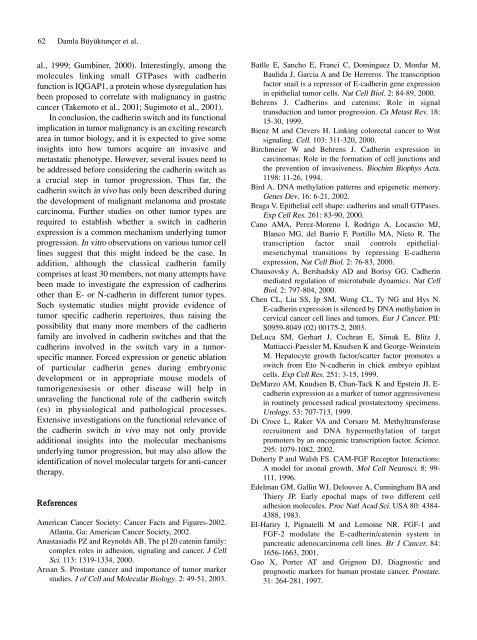(Converted)-5 - Journal of Cell and Molecular Biology - Haliç ...
(Converted)-5 - Journal of Cell and Molecular Biology - Haliç ...
(Converted)-5 - Journal of Cell and Molecular Biology - Haliç ...
You also want an ePaper? Increase the reach of your titles
YUMPU automatically turns print PDFs into web optimized ePapers that Google loves.
62 Damla Büyüktunçer et al.<br />
al., 1999; Gumbiner, 2000). Interestingly, among the<br />
molecules linking small GTPases with cadherin<br />
function is IQGAP1, a protein whose dysregulation has<br />
been proposed to correlate with malignancy in gastric<br />
cancer (Takemoto et al., 2001; Sugimoto et al., 2001).<br />
In conclusion, the cadherin switch <strong>and</strong> its functional<br />
implication in tumor malignancy is an exciting research<br />
area in tumor biology, <strong>and</strong> it is expected to give some<br />
insights into how tumors acquire an invasive <strong>and</strong><br />
metastatic phenotype. However, several issues need to<br />
be addressed before considering the cadherin switch as<br />
a crucial step in tumor progression. Thus far, the<br />
cadherin switch in vivo has only been described during<br />
the development <strong>of</strong> malignant melanoma <strong>and</strong> prostate<br />
carcinoma. Further studies on other tumor types are<br />
required to establish whether a switch in cadherin<br />
expression is a common mechanism underlying tumor<br />
progression. In vitro observations on various tumor cell<br />
lines suggest that this might indeed be the case. In<br />
addition, although the classical cadherin family<br />
comprises at least 30 members, not many attempts have<br />
been made to investigate the expression <strong>of</strong> cadherins<br />
other than E- or N-cadherin in different tumor types.<br />
Such systematic studies might provide evidence <strong>of</strong><br />
tumor specific cadherin repertoires, thus raising the<br />
possibility that many more members <strong>of</strong> the cadherin<br />
family are involved in cadherin switches <strong>and</strong> that the<br />
cadherins involved in the switch vary in a tumorspecific<br />
manner. Forced expression or genetic ablation<br />
<strong>of</strong> particular cadherin genes during embryonic<br />
development or in appropriate mouse models <strong>of</strong><br />
tumorigenesisesis or other disease will help in<br />
unraveling the functional role <strong>of</strong> the cadherin switch<br />
(es) in physiological <strong>and</strong> pathological processes.<br />
Extensive investigations on the functional relevance <strong>of</strong><br />
the cadherin switch in vivo may not only provide<br />
additional insights into the molecular mechanisms<br />
underlying tumor progression, but may also allow the<br />
identification <strong>of</strong> novel molecular targets for anti-cancer<br />
therapy.<br />
References<br />
American Cancer Society: Cancer Facts <strong>and</strong> Figures-2002.<br />
Atlanta, Ga: American Cancer Society, 2002.<br />
Anastasiadis PZ <strong>and</strong> Reynolds AB. The p120 catenin family:<br />
complex roles in adhesion, signaling <strong>and</strong> cancer. J <strong>Cell</strong><br />
Sci. 113: 1319-1334, 2000.<br />
Ar›san S. Prostate cancer <strong>and</strong> importance <strong>of</strong> tumor marker<br />
studies. J <strong>of</strong> <strong>Cell</strong> <strong>and</strong> <strong>Molecular</strong> <strong>Biology</strong>. 2: 49-51, 2003.<br />
Batlle E, Sancho E, Franci C, Dominguez D, Monfar M,<br />
Baulida J, Garcia A <strong>and</strong> De Herreros. The transcription<br />
factor snail is a repressor <strong>of</strong> E-cadherin gene expression<br />
in epithelial tumor cells. Nat <strong>Cell</strong> Biol. 2: 84-89, 2000.<br />
Behrens J. Cadherins <strong>and</strong> catenins: Role in signal<br />
transduction <strong>and</strong> tumor progression. Ca Metast Rev. 18:<br />
15-30, 1999.<br />
Bienz M <strong>and</strong> Clevers H. Linking colorectal cancer to Wnt<br />
signaling. <strong>Cell</strong>. 103: 311-320, 2000.<br />
Birchmeier W <strong>and</strong> Behrens J. Cadherin expression in<br />
carcinomas: Role in the formation <strong>of</strong> cell junctions <strong>and</strong><br />
the prevention <strong>of</strong> invasiveness. Biochim Biophys Acta.<br />
1198: 11-26, 1994.<br />
Bird A. DNA methylation patterns <strong>and</strong> epigenetic memory.<br />
Genes Dev. 16: 6-21, 2002.<br />
Braga V. Epithelial cell shape: cadherins <strong>and</strong> small GTPases.<br />
Exp <strong>Cell</strong> Res. 261: 83-90, 2000.<br />
Cano AMA, Perez-Moreno I, Rodrigo A, Locascio MJ,<br />
Blanco MG, del Barrio F, Portillo MA, Nieto R. The<br />
transcription factor snail controls epithelialmesenchymal<br />
transitions by repressing E-cadherin<br />
expression, Nat <strong>Cell</strong> Biol. 2: 76-83, 2000.<br />
Chausovsky A, Bershadsky AD <strong>and</strong> Borisy GG. Cadherin<br />
mediated regulation <strong>of</strong> microtubule dynamics. Nat <strong>Cell</strong><br />
Biol. 2: 797-804, 2000.<br />
Chen CL, Liu SS, Ip SM, Wong CL, Ty NG <strong>and</strong> Hys N.<br />
E-cadherin expression is silenced by DNA methylation in<br />
cervical cancer cell lines <strong>and</strong> tumors. Eur J Cancer. PII:<br />
S0959-8049 (02) 00175-2, 2003.<br />
DeLuca SM, Gerhart J, Cochran E, Simak E, Blitz J,<br />
Mattiacci-Paessler M, Knudsen K <strong>and</strong> George-Weinstein<br />
M. Hepatocyte growth factor/scatter factor promotes a<br />
switch from Eto N-cadherin in chick embryo epiblast<br />
cells. Exp <strong>Cell</strong> Res. 251: 3-15, 1999.<br />
DeMarzo AM, Knudsen B, Chan-Tack K <strong>and</strong> Epstein JI. Ecadherin<br />
expression as a marker <strong>of</strong> tumor aggressiveness<br />
in routinely processed radical prostatectomy specimens.<br />
Urology. 53: 707-713, 1999.<br />
Di Croce L, Raker VA <strong>and</strong> Corsaro M. Methyltransferase<br />
recruitment <strong>and</strong> DNA hypermethylation <strong>of</strong> target<br />
promoters by an oncogenic transcription factor. Science.<br />
295: 1079-1082, 2002.<br />
Doherty P <strong>and</strong> Walsh FS. CAM-FGF Receptor Interactions:<br />
A model for axonal growth. Mol <strong>Cell</strong> Neurosci. 8: 99-<br />
111, 1996.<br />
Edelman GM, Gallin WJ, Delouvee A, Cunningham BA <strong>and</strong><br />
Thiery JP. Early epochal maps <strong>of</strong> two different cell<br />
adhesion molecules. Proc Natl Acad Sci. USA 80: 4384-<br />
4388, 1983.<br />
El-Hariry I, Pignatelli M <strong>and</strong> Lemoine NR. FGF-1 <strong>and</strong><br />
FGF-2 modulate the E-cadherin/catenin system in<br />
pancreatic adenocarcinoma cell lines. Br J Cancer. 84:<br />
1656-1663, 2001.<br />
Gao X, Porter AT <strong>and</strong> Grignon DJ. Diagnostic <strong>and</strong><br />
prognostic markers for human prostate cancer. Prostate.<br />
31: 264-281, 1997.

















